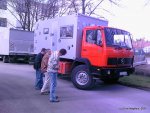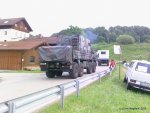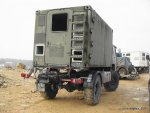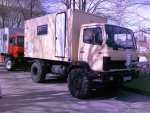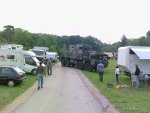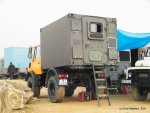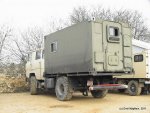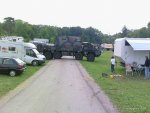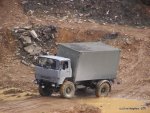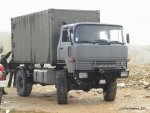apexcamper
Carefully scripted chaos
Has it been so long?
Wow...where has the time gone.
Sorry I haven't been on here more, lots of work and family stuff has been happening, and not work on the truck...
But now we are back at it. Going to try and take advantage of the Christmas break to make some progress.
So to update you since last:
We have settled on a 4 point system for mounting the box. I originally wanted to try something new or unique, but after weighing everything out, we went with something simple that we know works.
We also decided that, while I have done some small wood and interior projects, most of it has been replacing wiring or redoing some parts of a boat interior. Since my skills to date have been mostly repair and replace, working from scratch will be a challenge.
Not to worry, challenge accepted!
HOWEVER, we (read "wife") feel that there are a lot of costly materials that I have the "ever so slight potential to [screw] up". I PG-13d it with the word "screw"...you get the point.
So here is the new plan...we are building a "practice" RV
The truck isn't practice, of course, but the box will be. I found a company close to my house selling a 4.25 meter long mil-spec shelter. It is a former communication shelter from the Germany army. It has 2.25 inch thick plywood and foam walls with aluminum skin. On the inside it currently has a desk and packed wall to wall with radio racks (no radios).
BIG BONUS: Massive (don't know specs) 24v to 220v inverter, external 220v plugs for shore power as well as patch cables to connect to truck electrical system, large "master on" switch and separate 220v and 24v circuit breaker boxes, lighting, wiring, AND...
a diesel fired heater that worked WAY to efficiently to run for more that a couple of minutes.
We are going to gut this and build it up as a smaller version of what we want. Lets us hone our skills and start taking trips, learning what we do and don't need.
So, lets get started.
Here is the box, you can see the exhaust for the heater up front with it's own roll cage. The only windows are at the back, so we will cut and install some...great practice

Maggie is prepped and ready.

Using an old forklift, they managed to get it on straight, not on the first try, but straight none the less

AWESOMELY the box is designed for the truck itself, so we were able to use the shelter mounting points and chain tie downs that were already there. (ya...it was 35 degrees and raining slush)

It is really great to see things progressing again...I need a grinectomy

So there she is...we are going to leave the drop sides on for now since it gives us a little storage front and rear (front storage is 1 stinking inch short of holding a Jerry can long ways...1 stinking inch).

I will post up pics of the inside of the shelter tomorrow.
Wow...where has the time gone.
Sorry I haven't been on here more, lots of work and family stuff has been happening, and not work on the truck...
But now we are back at it. Going to try and take advantage of the Christmas break to make some progress.
So to update you since last:
We have settled on a 4 point system for mounting the box. I originally wanted to try something new or unique, but after weighing everything out, we went with something simple that we know works.
We also decided that, while I have done some small wood and interior projects, most of it has been replacing wiring or redoing some parts of a boat interior. Since my skills to date have been mostly repair and replace, working from scratch will be a challenge.
Not to worry, challenge accepted!
HOWEVER, we (read "wife") feel that there are a lot of costly materials that I have the "ever so slight potential to [screw] up". I PG-13d it with the word "screw"...you get the point.
So here is the new plan...we are building a "practice" RV
The truck isn't practice, of course, but the box will be. I found a company close to my house selling a 4.25 meter long mil-spec shelter. It is a former communication shelter from the Germany army. It has 2.25 inch thick plywood and foam walls with aluminum skin. On the inside it currently has a desk and packed wall to wall with radio racks (no radios).
BIG BONUS: Massive (don't know specs) 24v to 220v inverter, external 220v plugs for shore power as well as patch cables to connect to truck electrical system, large "master on" switch and separate 220v and 24v circuit breaker boxes, lighting, wiring, AND...
a diesel fired heater that worked WAY to efficiently to run for more that a couple of minutes.
We are going to gut this and build it up as a smaller version of what we want. Lets us hone our skills and start taking trips, learning what we do and don't need.
So, lets get started.
Here is the box, you can see the exhaust for the heater up front with it's own roll cage. The only windows are at the back, so we will cut and install some...great practice

Maggie is prepped and ready.

Using an old forklift, they managed to get it on straight, not on the first try, but straight none the less

AWESOMELY the box is designed for the truck itself, so we were able to use the shelter mounting points and chain tie downs that were already there. (ya...it was 35 degrees and raining slush)

It is really great to see things progressing again...I need a grinectomy

So there she is...we are going to leave the drop sides on for now since it gives us a little storage front and rear (front storage is 1 stinking inch short of holding a Jerry can long ways...1 stinking inch).

I will post up pics of the inside of the shelter tomorrow.

























